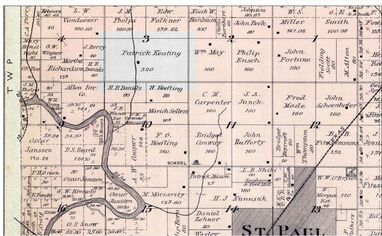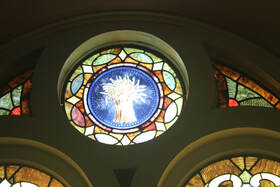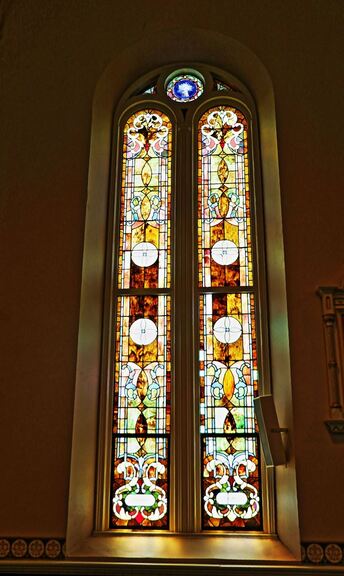13. The Mr. and Mrs. Patrick Keating Window.
|
The Mr. and Mrs. Patrick Keating window is 70 inches wide and 18 feet tall. The window is located on the east side of the church between the 6th and 7th Stations of the Cross. [1]
The story of Patrick and Mary Keating is similar to those of many of the other donors and, in fact, many Osage Mission - St. Paul settlers. The Keating's were both first-generation immigrants. They made a few stops along the way after landing in New York, eventually ending up here. While Patrick initially worked as a railroad laborer they seemed to arrive here enjoying a fair amount of affluence. The farm on which they made their living was on another Kansas historic site. Like other donors, three of the Keating daughters pursued religious vocations. However, one of the three experienced a truly remarkable event while at the Loretto Mother House in Nerinx, Kentucky. The Keating story, in the Who's Behind the Window? manuscript includes more than 20 pages of details and news articles about family moves, business, illnesses, tragedy and their eventual deaths. Like other sections, it is a genealogist's treasure chest
|
It appears as though the Patrick Keating, who arrived in New York, from Limerick, Ireland on April 24th, 1865, is the same Patrick Keating (1836-1924) who married Mary Margarette Mason (1840-1925) in about 1864. Patrick and Mary spent time residing in Lee's Summit, Missouri, where Pat's occupation is railroad laborer. At that time the Federal Census shows them without children. By 1868, they are located in Pettis County Missouri (about 90 miles southwest of Kansas City) when their son Michael is born. Following are the births of Catherine (1873), Margaret (1878), and Ellen (1880}. Patrick is listed as a railroad section hand at the nearby Sedalia railhead where the Missouri Pacific MK&T railroads operated.
The family arrived in Osage Mission sometime before March 10th of 1884 when they purchased one of the larger farms in the area which was located in Township 029s in Range 20. This section is where one of the earliest Indian Missions was established in Neosho County and Kansas.[2] The family immediately settled in and occasional news stories mentioned mentioned them with regard to schools, first communions, farming and a short-term, humorous labor strike related to harvest. Among the news stories was one of the tragic death of fourteen year-old Peter Smith who was killed by a freight train near Walnut, Kansas. Peter was an orphan who was reared by the Keating's since early childhood.
In 1911 the Keating's sold their farm and relocated to Muskogee, Oklahoma to be closer to a daughter. However, the relocation wasn't agreeable and they were back in St. Paul in little more than one year. Here, they established a home within the city but spent time clearing up some legal issues back in Oklahoma.
In 1916 Patrick Keating fell seriously ill and entered the State Hospital in Parsons. The nature of the long illness is unknown but he would not recover. He passed at that hospital on June 15, 1924. Mary Keating's home on Jefferson Street in St. Paul burned in February of 1922 and she returned to Muskogee where she lived with a daughter until her death on December 27, 1925. Both Patrick and Mary are buried in St. Francis Catholic Cemetery, St. Paul.
Like several other window donors, the Keating family included three women who followed religious vocations:
The family arrived in Osage Mission sometime before March 10th of 1884 when they purchased one of the larger farms in the area which was located in Township 029s in Range 20. This section is where one of the earliest Indian Missions was established in Neosho County and Kansas.[2] The family immediately settled in and occasional news stories mentioned mentioned them with regard to schools, first communions, farming and a short-term, humorous labor strike related to harvest. Among the news stories was one of the tragic death of fourteen year-old Peter Smith who was killed by a freight train near Walnut, Kansas. Peter was an orphan who was reared by the Keating's since early childhood.
In 1911 the Keating's sold their farm and relocated to Muskogee, Oklahoma to be closer to a daughter. However, the relocation wasn't agreeable and they were back in St. Paul in little more than one year. Here, they established a home within the city but spent time clearing up some legal issues back in Oklahoma.
In 1916 Patrick Keating fell seriously ill and entered the State Hospital in Parsons. The nature of the long illness is unknown but he would not recover. He passed at that hospital on June 15, 1924. Mary Keating's home on Jefferson Street in St. Paul burned in February of 1922 and she returned to Muskogee where she lived with a daughter until her death on December 27, 1925. Both Patrick and Mary are buried in St. Francis Catholic Cemetery, St. Paul.
Like several other window donors, the Keating family included three women who followed religious vocations:
- Catherine Ann, Sister Flosellia (1873-1940) Sisters of Loretto
- Mary Agnes, Sister Alfred Keating* (1875-1961) Sisters of Loretto
- Margaret, Sister Mary Keating (1878-1944) Sisters of Loretto
 Keating Farm (Click to enlarge)
Keating Farm (Click to enlarge)
Some Reference Information.
1. The name inscribed on the oval at the base of the Keating Window was misspelled (Keeting).
2. The Keating farm was located about two miles north and a mile west of Osage Mission - St. Paul. There they owned 320 acres or 1/2 section. This section is where the the second Indian Mission established in Kansas was located. Boudinot Mission was operated from 1830 to 1837. Boudinot followed, and replaced, Mission Neosho (1824-1829) which was located a few miles north near present Shaw Kansas. The failure of Mission Neosho was attributed to the volatile relationship its director had with both the Osage and the white officials. Follow THIS LINK for more information about the early Protestant missions. Both of these missions pre-dated Osage Mission by several years.
1. The name inscribed on the oval at the base of the Keating Window was misspelled (Keeting).
2. The Keating farm was located about two miles north and a mile west of Osage Mission - St. Paul. There they owned 320 acres or 1/2 section. This section is where the the second Indian Mission established in Kansas was located. Boudinot Mission was operated from 1830 to 1837. Boudinot followed, and replaced, Mission Neosho (1824-1829) which was located a few miles north near present Shaw Kansas. The failure of Mission Neosho was attributed to the volatile relationship its director had with both the Osage and the white officials. Follow THIS LINK for more information about the early Protestant missions. Both of these missions pre-dated Osage Mission by several years.

3. The Mr. & Mrs. Patrick Keeting stained glass in crowned with the sign of the Wheat Harvest. Which signifies an advancing state of love and charity. As well as Jesus is the Bread of Life. (Photo - R. Brogan)

